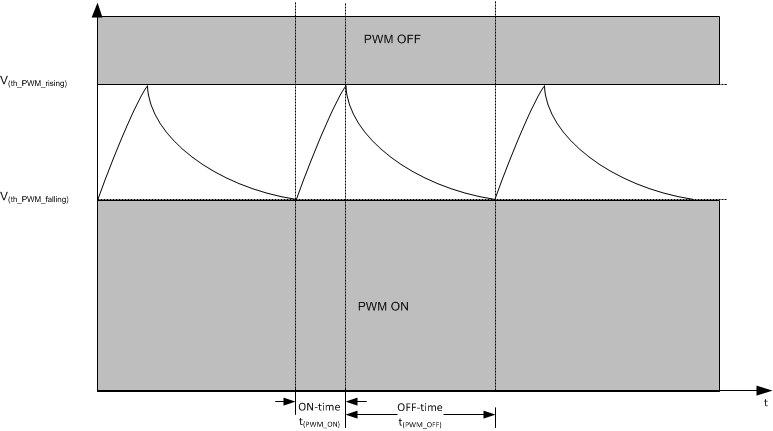SLIS178B October 2017 – January 2018 TPS92830-Q1
PRODUCTION DATA.
- 1 Features
- 2 Applications
- 3 Description
- 4 Revision History
- 5 Description (Continued)
- 6 Pin Configuration and Functions
- 7 Specifications
- 8 Detailed Description
- 9 Application and Implementation
- 10Layout
- 11Device and Documentation Support
- 12Mechanical, Packaging, and Orderable Information
8.3.4.3 Internal Precision PWM Generator
The TPS92830-Q1 device has an integrated precision PWM generator for on-chip PWM dimming as shown in . The device supports open-drain PWMOUT for synchronization between devices. Each device can be connected as a master, generating PWM, or as a slave, relying on external PWM sources. An external RC circuit precisely sets the duty cycle of the PWM generator across a wide duty-cycle range. Variation of the capacitor value affects the output frequency but not the duty cycle.
The PWM generator uses reference current 2 × I(IREF) as the internal charge current, I(PWMCHG).
When V(PWMCHG) increases above rising threshold V(PWMCHG_th_rising), the constant-current source is turned off and V(PWMCHG) decays through the external resistor-capacitor circuit. The PWM output is set LOW. The PWMCHG threshold is set to V(PWMCHG_th_falling). When V(PWMCHG) decreases below falling threshold V(PWMCHG_th_falling), the constant-current source is turned on again to charge up the external capacitor. The PWM output is HIGH and the threshold is set to V(PWMCHG_th_rising).
 Figure 23. PWM Generator Dual-Brightness Configuration
Figure 23. PWM Generator Dual-Brightness Configuration An external resistor R(PWMEXT) and capacitor C(PWMEXT) are used to set the PWM cycle time.




 Figure 24. PWM Dimming Profile
Figure 24. PWM Dimming Profile